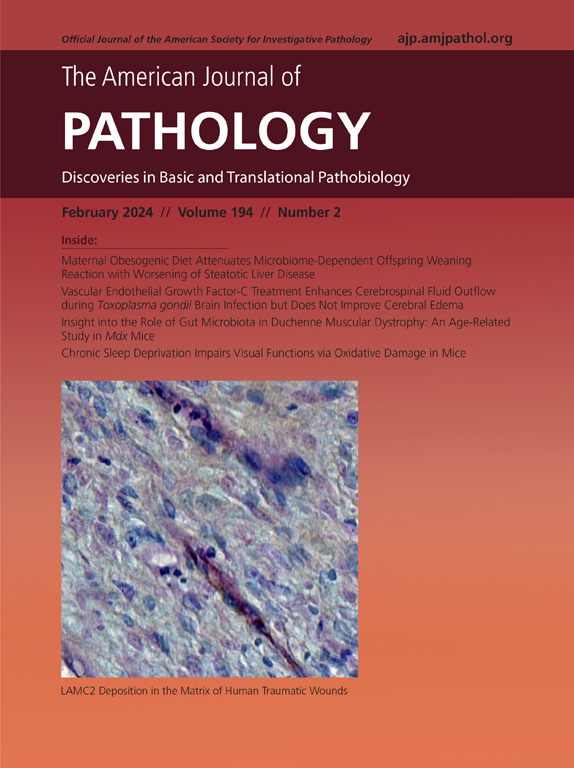Metabolic Dysfunction–Associated Steatotic Liver Disease in Patients and Mice with Wilson Disease
IF 3.6
2区 医学
Q1 PATHOLOGY
引用次数: 0
Abstract
Wilson disease (WD) is a copper metabolism disorder caused by ATP7B gene mutations, and hepatic steatosis is not uncommon in WD. Therefore, the effects of ATP7B (ATPase copper-transporting beta) deficiency and/or a high-fat diet (HFD) on the development of steatohepatitis were investigated in mouse models and the relationship of hepatic steatosis with cardiometabolic factors was examined in patients with WD. A retrospective analysis of data was conducted on adults with WD. Of the 61 patients with WD, 11.5% had evidence of hepatic steatosis, significantly linked to cardiometabolic factors. Clustered regularly interspaced short palindromic repeats/CRISPR-associated protein 9 (CRISPR/Cas9) was used to generate Atp7b gene knockout (KO) mice, followed by a comprehensive phenotypic analysis. A HFD was administered to induce steatohepatitis, allowing for analysis of lipid metabolism and hepatic injuries in KO mice subjected to overnutrition. Although ATP7B KO mice under normal diet exhibited significant copper metabolism disorders without overt hepatic or neurologic injury, steatohepatitis was successfully induced in both wild-type and KO mice after 24 weeks of HFD. Compared with a normal diet, a HFD resulted in markedly decreased hepatic copper levels with obvious liver injury in KO mice. Moreover, HFD-fed KO mice exhibited significantly higher severity of hepatic steatosis, inflammation, and fibrosis than wild-type control mice. Results suggest that hepatic steatosis in WD relates more to acquired metabolic dysfunction than excess copper accumulation, underscoring the influence of nutritional excess on WD phenotypes.
肝豆状核变性患者和小鼠的代谢功能障碍相关脂肪变性肝病
威尔逊氏病(WD)是一种由atp7b基因突变引起的铜代谢障碍,肝脂肪变性在威尔逊氏病中并不少见。因此,我们在小鼠模型中研究了ATP7B缺乏和/或高脂肪饮食(HFD)对脂肪性肝炎发展的影响,并研究了WD患者肝脏脂肪变性与心脏代谢因子的关系。对成年WD患者的资料进行回顾性分析。通过CRISPR/Cas9技术实现Atp7b基因敲除(KO),然后进行全面的表型分析。用HFD诱导脂肪性肝炎,分析营养过剩下KO小鼠的脂质代谢和肝脏损伤。在61例WD患者中,11.5%发现肝脂肪变性,并与心脏代谢因素显著相关。虽然正常饮食下的ATP7B KO小鼠表现出明显的铜代谢障碍,但没有明显的肝脏或神经损伤,但在24周的HFD后,野生型和KO小鼠都成功地诱导了脂肪性肝炎。与正常饮食相比,HFD导致KO小鼠肝铜含量明显降低,肝损伤明显。此外,hfd喂养的KO小鼠肝脏脂肪变性、炎症和纤维化的严重程度明显高于宽型对照组。结果表明,与过量铜积累相比,WD的肝脂肪变性更多地与获得性代谢功能障碍有关,强调了营养过剩对WD表型的影响。
本文章由计算机程序翻译,如有差异,请以英文原文为准。
求助全文
约1分钟内获得全文
求助全文
来源期刊
CiteScore
11.40
自引率
0.00%
发文量
178
审稿时长
30 days
期刊介绍:
The American Journal of Pathology, official journal of the American Society for Investigative Pathology, published by Elsevier, Inc., seeks high-quality original research reports, reviews, and commentaries related to the molecular and cellular basis of disease. The editors will consider basic, translational, and clinical investigations that directly address mechanisms of pathogenesis or provide a foundation for future mechanistic inquiries. Examples of such foundational investigations include data mining, identification of biomarkers, molecular pathology, and discovery research. Foundational studies that incorporate deep learning and artificial intelligence are also welcome. High priority is given to studies of human disease and relevant experimental models using molecular, cellular, and organismal approaches.

 求助内容:
求助内容: 应助结果提醒方式:
应助结果提醒方式:


